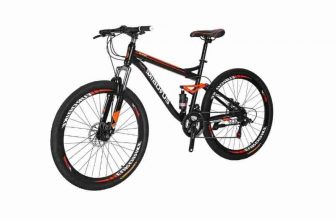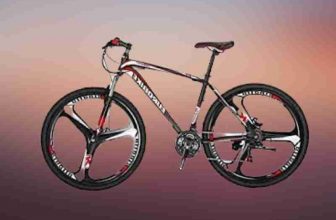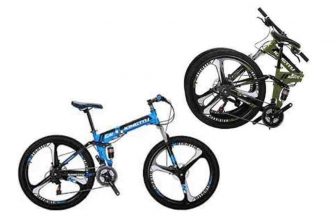
Mountain bikes and road bikes are two very different types of bicycles used for entirely other purposes. There are obvious distinctions, such as wheels, frames, and handlebars, but many features aren’t immediately apparent. Mountain bikes and road bikes are used for entirely different things.
The most significant distinction is in terms of speed and endurance. A road bike is designed to go longer distances at higher speeds, but a mountain bike is designed to travel off-road and is less suitable for long trips. Both have many sorts of gear and parts built for specific uses.
Even though there are more differences than parallels between road bikes and mountain bikes, they are two of the most popular bike styles. Many riders do both (though not simultaneously), and even professional cyclists compete in six-hour road races and explosive cross-country mountain riding.
Throughout this article, we will examine the differences between road bikes and mountain bikes and what makes one superior to the other.
Bicycles on the Road
Road bikes are designed for speed, with narrow tires on paved roads to travel quickly and far. Versions with disc brakes are becoming more widespread. Women’s-specific versions are available from many brands, and they include distinct contact points (saddle, handlebars, and sometimes crankarm length) for women’s anatomy, as well as women’s-specific frame geometry.
Types
With their wing-shaped frame tubes and wheels, these bikes offer the least amount of drag possible. The rider positions tend to be more aggressive, emphasizing speed rather than comfort, as they’re made for racing or time trials.
Alternatively, you can get an ultralight bike designed for long climbs and uses the lightest materials. These bikes may not be suitable for all kinds of riding.
Endurance: These bikes have a more upright riding position for comfort, slightly bigger tires and gearing ranges, and, occasionally, vibration-absorbing technologies in the Frame and fork.
Touring: These compact roadsters are designed for all-day comfort and cargo capacity. Long wheelbases and solid steering provide confident handling, while rack and bag accessory mounts allow you to prepare for long-distance, self-supported journeys.
All-Road: This relatively recent type (also known as road-plus or pavement-plus) combines clearance for considerably larger tires (up to roughly 38mm wide) with a more typical road bike geometry that boasts faster steering and an aerodynamically efficient rider position.
Purpose
On smooth pavement, a road bike should be light and responsive. Narrow 700c wheels and thin tires boost speed on these bikes by reducing rolling resistance. Racing road bikes are intended for performance to shave seconds off a rider’s time in the competition.
Road bikes put the rider in a forward-leaning, aggressive stance, enhancing aerodynamics and power transfer to the pedals. Because the Frame must be light and robust, materials such as carbon fiber and titanium are commonly used at the competitive level. Steel and aluminum, as well as other powerful and light materials, fill out the consumer market.
Price
Around $800 gets you a good road bike with aluminum frames, 18-speed drivetrains, and traditional rim brakes. Exotic materials, 22-speed computerized drivetrains, hydraulic disc brakes, and ultra-low weights are all standard on super high-end models, costing well over $15,000.
Mountain Bikes
What it is: These rugged, robust bikes are designed to ride small dirt paths. A broad, flat handlebars bicycle provides traction with knobby tread; it has a wide range of gears and hydraulic disc brakes to provide traction on steep climbs and descents.
Wheels usually are 27.5-inch or 29-inch in diameter; the earlier 26-inch is quickly becoming obsolete. Women’s bikes have smaller grips, narrower handlebars, and shorter crank arms, as well as women’s-specific seats. For smaller riders, most feature lighter suspension adjustment.
Types
Hardtails have suspension forks on a stiff frame, as the name suggests. They are usually the least expensive, but high-end racing models are also.
XC Full-Suspension: Features a rear suspension with a shorter trip (110mm or less) to promote low bike weight and efficiency under power, especially on hills.
Trail Full-Suspension: A mid-travel (120-150mm) suspension balances climbing efficiency and descent abilities. Tires become wider, and brake rotors become larger for more stopping force. Some models are “Plus” compatible, with traditional 29-inch wheels or plus-size 27.5×3-inch rubber.
Full-Suspension Enduro/Gravity: These bikes are designed for greatest control when descending, especially on steep, rough terrain, with 160mm or more rear-wheel travel, powerful brakes, and aggressive tire treads.
Purpose
Mountain bikes are built to handle dirt, mud, snow, and gravel from off-road conditions. These bikes are built to last, with thick tires and robust wheels that withstand impact damage. Aluminum, carbon fiber, steel, and titanium are used to construct the frames, designed to take a lot of abuse.
Suspension systems enable the wheels to absorb vibration and impact from challenging terrain. A hardtail mountain bike has front-wheel suspension, but a full-suspension mountain bike has shock absorption in both wheels. Flat handlebars are standard on mountain bikes, putting the rider in an upright position for balance and control.
Price
A basic hardtail for casual trail riding can cost as little as $400, while top-of-the-line trail and enduro-style bikes with carbon fiber frames, wheelsets, and sophisticated suspension can cost as much as $10,000.
What’s the Difference Between a Road and a Mountain Bike?
The wheels are the most apparent distinction between road and mountain bikes. Mountain bike wheels are available in sizes ranging from 26 to 29 inches, with increased lugs on all tires. These lugs dig into loose soil-like teeth, offering traction and grip where a road bike’s smooth tires would slip. The tires on a road bike are narrower and without lugs, providing appropriate traction and control on the pavement. Other notable distinctions include:
Mountain Bikes vs Road Bikes
Road bikes are designed to ride on various types of paved surfaces. These are roads in cities, country roads, cycling trails, mountain passes, and more. These bikes are light and aerodynamic, and they’re built to go fast in a straight line as well as uphill. They’re fast thanks to their frame geometry, components, and handlebar design, and you’ll never want to ride your road bike off-road.
Mountain bikes are practically the polar opposite of road bikes in that they are designed for off-road riding. Mountain bikes’ thick tires and treads make them slow on the pavement as if the weighty Frame wasn’t already slowing you down, but they’re ideal for keeping you upright on rocky, muddy singletrack paths.
Mountain bikes’ flat handlebars and suspension systems are designed to improve handling and comfort off-road, particularly on steep and technical singletrack.
The frame architecture of a mountain bike is meant to assist soften impacts and improve balance through bumpy sections, and it comes equipped with powerful disc brakes and wide gearing ranges for all types of off-road terrain.
The geometry of the Frame
Starting with the Frame, the excellent road bikes are meant to be compact and aerodynamic, unlike mountain bikes designed to be stable across rugged terrain. In comparison to mountain bikes, road bikes have a longer reach and top tube, which allows the rider to extend their legs for an aerodynamic stance.
Different fork offset (also known as fork ‘rake’) is the distance between a straight line through the steerer tube of the fork and a vertical line through the front hub.
When riding a road bike, the fork rake is shallow, resulting in sharp handling, while on a mountain bike, the fork rake is massive, and the head tube angle is slacker, keeping the rider’s center of gravity balanced during steep descents.
This feature effectively puts the front wheel further out in front of the Frame on a mountain bike, improving leverage and control.
Mountain bikes feature a shorter reach and top tube than road bikes, which allows for better handling by keeping the handlebars closer to the rider. On a mountain bike, this results in a more upright – and less aerodynamic – stance, which is better for tight bends, off-road handling, and keeping your center of gravity low and central.
Finally, the trail is a sophisticated measurement that combines the head tube angle with the fork rake to determine the distance between the tire contact point and the steering axis.
All you need to know is that a road bike has a steep head tube and a wider fork offset to reduce trail and improve handling. Endurance mountain bikes have longer tracks, enhancing stability and allowing for more incredible high-speed maneuvering on rocky terrain.
Pedals
I’m not referring to factory-installed pedals. The gap between MTB paddles and road bike pedals is significant. Road bikers frequently utilize mountain bike pedals, although there are some distinctions.
Both include a mechanism that keeps your shoes on the paddle when you’re not using them. The cleat size that attaches to the shoe sole is the difference. Mountain bike pedals have short cleats that make unlocking them easier.
This makes sense because you’re more likely to fall off a mountain bike while riding trails, and being unable to unlock it would be a far more painful experience. As a result of the larger cleats on road bikes, a greater contact surface exists between the shoe sole and the pedals.
Mountain bikes and road bikes have flat pedals, depending on your tastes.
Brakes and Gearing
Most modern mountain bikes have a 1x setup, which means there is only one front chainring. The chain breakage problem is reduced since there is no need for an expensive, large, and finicky front derailleur.
Mountains bikes have only one front chainring and must traverse steep terrain, so they need a large rear cassette and a wide gear range. Some cassettes have acquired the nickname “dinner plates” due to their enormous size; some reach as high as a 50t rear cog.
Now, mountain bike manufacturers produce 11-speed and 12-speed cassettes with cogs ranging from 10t to 50t, giving you the versatility to gear up rapidly for steep climbs on singletrack and rapid descents with a 1x setup.
When it comes to road bike gearing, there are many more possibilities, including compact and race-ready setups. Most road cycles feature a 2x design, which means they have two front chainrings and a front derailleur, with the most common configurations being 53/39, 52/36, and 50/34.
Most road cassettes are 11-speed, with sprockets ranging from 11 to 28 teeth, but many riders opt for even larger alternatives to cope with rugged hills.
Many road cyclists, particularly those who ride for fun, prefer a compact chainring setup with smaller front chainrings and larger rear cogs. This restricts your upper-end performance (at high speeds), but it lets you maintain a comfortable cadence on extremely steep hills. You may still be pedaling at 80rpm up a 9% hill with a tiny chainring arrangement.
There is only one option for mountain bikes for brakes: disc brakes. Disc brakes are the finest for off-road riding since they are large, strong, and operate well in the rain.
Disc brakes provide more tire clearance, ideal for mountain bikes with wide, knobbly tires. Riders employ larger-than-normal disc brakes for downhill riding and extreme mountain biking, boosting stopping power, performance, and high speeds.
After decades of using rim brakes, most road manufacturers have recognized the benefits of disc brakes on road bikes and have begun putting them on all road models.
While many were skeptical about weight, aerodynamics, and safety, technology appears to have caught up with the concerns, and disc brakes are now a standard feature on road bikes.
Rim brake road bikes are still available on the market. Although they are often lighter than disc brakes, they have not proven as reliable in wet conditions. There is no modulation in rim brakes, and they are less powerful due to their simplicity and low cost.
Disc brake bikes are more difficult to set up and maintain than rim brake bikes, which are easier to use. Most bike technology (trainers, vehicle racks, and bike stands) is designed for rim brake bikes.
Tires & Wheels
Mountain bike wheels are typically larger in diameter and stronger than road bike wheels. In comparison to road bikes, they are also much broader and feature different tire profiles. Because road bike wheels aren’t as wide as mountain bike wheels, there’s less surface friction, which implies higher speed with less effort.
Suspension
Suspension is one of the most distinctive features of a mountain bike, and it’s something you won’t find on a road bike. Mountain bikes are divided into two types based on their suspension systems: hardtail and full suspension.
The front suspension, generally in the fork, is included in hardtail mountain bikes. These systems are stiffer than full-suspension mountain bikes, ranging from 100 to 170mm. Cross-country and short-track racing are suitable for hardtail mountain bikes as they are lighter than full-suspension mountain bikes.
Both front and rear suspension are used in full-suspension mountain bikes, enhancing overall comfort and handling rough and technical terrain. These bikes are substantially heavier and more expensive than hardtail mountain bikes, but they perform significantly better on challenging routes.
Complete suspension mountain bikes can range from 100 to 200mm, making them perfect for trail riding, downhill mountain biking, and racing.
Handlebars
Various designs and shapes are available for handlebars. MTB handlebars are wide and flat, while road bikes have drop bars. Flat handlebars provide more control and make braking with one finger easier.
Flat bars are superior for climbing, although they put more significant strain on the wrists. Drop handlebars are narrower than standard handlebars, making it simpler to squeeze through tight spaces.
Position of Riding
There are significant distinctions between a road cycling stance and a mountain bike position. You’ll be stretched out on a road bike with a longer reach, a closed hip angle, and a forward-leaning position.
You’ll be seated much more upright on a mountain bike due to the narrow space, slacker head tube angle, and flat handlebars. The wide tires and suspension will make you more comfortable on rocky terrain, and on a slower mountain bike ride, you won’t have to worry about aerodynamics.
Endurance road bikes have a more relaxed shape, making them less aerodynamic but more comfortable over long distances. These are the bikes built for all-day adventures, with a more upright riding position to preserve your back and arms while maintaining many of the same fast and enjoyable road bike features.
Quick Benefits and Drawbacks
Pros
· It is extremely light and maneuverable, designed for speed.
· To maximize power, you should keep your torso over the handlebars.
· It is best to ride with maximum leg power and speed.
· Keeping the components working well is very easy.
· Lighter frames and thinner tires reduce friction.
· Depending on your budget, various options range from under $1,000 to under $2,000 for more delicate options.
Cons
· They aren’t quite as challenging as mountain bikes.
· It can’t be used on any terrain that isn’t paved.
· Because of the high terror range, it’s tough to ride slowly.
· Wrists and neck are put under a lot of strain.
· Most Commonly Asked Questions
How much easier is riding a road bike than riding a mountain bike?
It is not a question of which bike is easiest to ride. Because a road bike demands you to sit in a forward-leaning position, you’ll probably be more comfortable on a mountain bike. This is also true when riding a mountain bike, albeit slightly.
Road bikes are quicker than mountain bikes for what reason?
A road bike is often faster than a mountain bike due to its lighter build, thinner tires, which generate less friction between the bike and the surface, and the fact that it is cycled on the road, which is flatter and smoother terrain. Speed and long-distance travel are the goals of road bikes.
Is it legal to ride a mountain bike on the road?
Yes, mountain bikes can be ridden on roads, to put it simply. It is not ideal for riding a mountain bike on a road as they are meant for riding on trails, but it can be done. The best bikes for mountain and trail riding are mountain bikes specifically designed for mountain and trail riding. It is possible to get to point A or point B by riding your mountain bike on the road! Although there are certain drawbacks, it surely will accomplish the task!
Is riding a mountain bike on the road more difficult?
Yes, in general. Mountain bike tires are thicker than road bike tires. The tires on specific mountain bikes can be extensive. Riding on a flat surface might be pretty challenging due to this.
Because the amount of friction produced is more than on a road bike, this is the case. And there will be more opposition. As a result, you’ll have to put in more work. On the road, mountain bikes are more challenging to ride and move slower.
However, they provide a comfortable ride, an upright riding position, and the ability to travel on various surfaces. It won’t be too harsh for you to get lethargic. You won’t be as fast as you would be on a road bike.
A hybrid bike is another option. Hybrid or cross bikes are similar to road bikes in terms of speed and ease of use while also being similar in terms of comfort and versatility to mountain bikes.
Is riding a mountain bike on the road dangerous?
I don’t think so. It will not be harmed by riding on the road with a mountain bike. Mountain bikes, however, are designed specifically for traveling off-road and climbing hills. Mountain bikes can be used on the road without posing any danger.
If you’ve ever attempted off-road biking on a conventional road bike, you know how difficult it is. Mountain bikes are too light and fragile to be used on the road.
It can be challenging to ride a mountain bike on the road, and this is because the thick tires and heavy Frames will create some resistance on a flat surface. Also, you won’t maintain the same degree of momentum.
A mountain bike can be damaged by wear and tear when ridden on roads. Using a mountain bike only for mountain biking is a good idea.
If you use it daily, you will need to do more maintenance. Unfortunately, some people don’t have the financial means or the storage space to store many bicycles. Consequently, you can ride a mountain bike on the road.
Why are mountain bikes less expensive than road bikes?
On average, a road bike costs twice as much as a mountain bike. Road bikes tend to employ lighter carbon fiber components and more expensive groupsets. Mountain bikes, on the other hand, are built to be rugged and robust. Because weight is less of an issue, they can be fashioned of heavier — and thus less expensive — materials. It’s the same reason that a Formula One car costs more than a dump truck.
You’d think that because mountain bikes are used on rugged terrain, where things break readily and frequently, manufacturers would provide excellent warranties on their mountain bike parts. This will have an impact on the cost of parts and labor.
Road bikes are typically not used on the same terrain as mountain bikes. On the other hand, road bikes use bike parts designed to last an extended period. These bike parts must be lightweight while still strong enough to withstand the forces generated by the user while cycling at high speeds.
If you check at the markup for one of your favorite road bike companies, you’ll notice that they sell their bikes for around twice what they cost to produce. However, as demand for quicker and lighter road bikes grows, the cost of these bikes rises year after year.
What is the difference between a mountain bike and a road bike in terms of speed?
A mountain bike will likely allow you to go 15-20% slower on the road than a road bike. That is, if the rider pedals with the same amount of effort. When riders transition to mountain bike tires, they typically perceive a 2 to 3 mph speed increase.
Mountain bikes have knobs, which is one of the main reasons they are so slow on the road. The grip is vital for safety when riding a motorcycle off-road on the trails, and it’s for this reason all-mountain bike tires have knobs. This is fantastic on the trails, but it can significantly slow you down on the road.
Is it better to work out on a road bike or a mountain bike?
Both types of bikes provide a terrific workout, but they are best suited for various kinds of exercises. If you ride long distances, road riding is an excellent cardio exercise. Mountain biking involves additional pedaling effort, which works mountain riders’ leg muscles. It would be best to use your core muscles, shoulders, and arms to navigate tight turns and rough terrain. You receive a better full-body workout when riding a mountain bike on challenging terrain.
Mountain bikes are great for endurance and muscle development, while road bikes are better for cardio and overall body training. Before deciding whether to walk out into the wilderness or take on the rigors of the roads, be sure you are entirely prepared to take on the risks of either.
Final Thoughts
Mountain bikes have many attributes that make them more comfortable off-road and a popular choice for casual commuters on pavement and bike trails. It won’t travel as quickly as a road bike, but the riding position and shock absorption make potholes and curbs a breeze to avoid.
If you ride on pavement and want a quicker bike, road bikes are the way to choose because they make cycling and climbing hills considerably easier. They are also easier to operate at faster speeds due to their small weight.






